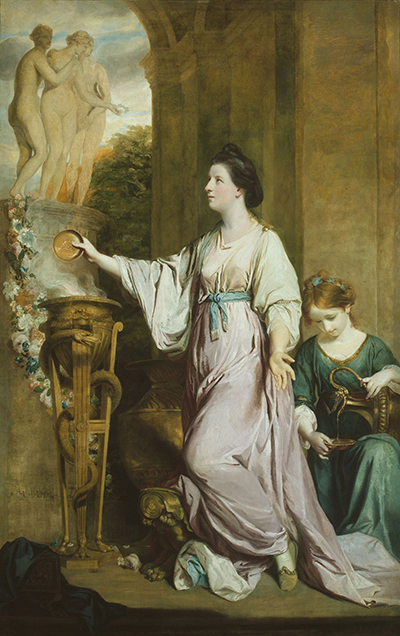 Buy Art Prints Now
Buy Art Prints Nowfrom Amazon
* As an Amazon Associate, and partner with Google Adsense and Ezoic, I earn from qualifying purchases.
Lady Sarah Bunbury Sacrificing to the Graces, created in 1765, is an oil-on-canvas painting by Joshua Reynolds that shows an aristocratic woman making a votive offering to the three daughters of Zeus.
Lady Sarah, daughter of the Duke of Richmond and Lennox, had been a prominent figure at the court of George III before she married Sir Charles Bunbury in 1762 while the three daughters of Zeus were minor goddesses who were known as the Charities or Graces. Aglaea, Euphrosyne and Thalia were worshipped from Classical Antiquity until Late Antiquity and represented splendour, good cheer as well as festivity. A resurgence of interest in Graeco-Roman polytheism during the 18th century, as part of a renewed appreciation of classical civilisations, meant that ancient deities often appeared in the era’s paintings.
Reynolds was a leading proponent of Neoclassicism, a cultural movement of the 18th century that sought to emulate Graeco-Roman civilisation, and sought to infuse his contemporary portraits with historic themes. Sir Charles Bunbury, whose marriage to the adulterous Lady Sarah was ended by Act of Parliament in the year following the painting’s completion, commissioned his wife's portrait so that her image could be preserved for posterity. The English artist, influenced by the Platonist philosophies of Zachariah Mudge and taught the trade of portraiture by Thomas Hudson, portrayed Lady Sarah as devotee of the Graces in order to draw parallels between her public persona and what the goddesses represent.
Lady Sarah, standing beneath a stone archway, is pouring a libation into a bronze brazier that is situated in front of a cylindrical plinth on which the Charities are standing. The fumes, consisting of smoke from the fire and vapour from the libation, waft up towards the goddesses who look favourably upon their devotee. A servant girl, adorned in a green gown, is pouring clear liquid from a jug into a cup and it is likely that this is the next in a series of libations that will be poured onto the sacrificial fire. The Charities are associated with Aphrodite, whose Roman counterpart is Venus, and this may be a reflection on Lady Sarah’s beauty as well as her reputation as a lover. One of the goddesses, flanked between the other deities and holding out her hand, seems to be inviting her devotee to join them.



